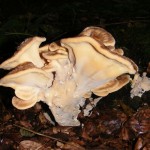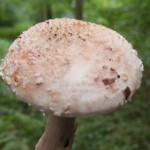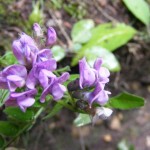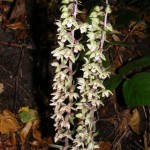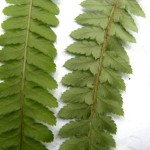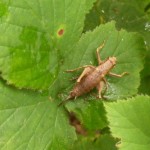Julia Cooper led a walk at Nippers Grove near Hook End, between Woodcote and Sonning Common, on Saturday 24th August. The previous week, Jerry Welsh had walked round the route with Julia and Ian, pointing out some of the botanical and archaeological highlights. It was threateningly cloudy at the start of the walk and the rain did indeed begin to fall quite heavily soon afterwards. The walk started out along the strip of woodland on the north-east side of Park Lane. Bell Heather and Wood Sage were unusual finds for South Oxfordshire. There were bright red berries on the Honeysuckle plants. An enormous fungus with fan-shaped layers coming up from a common base was subsequently identified as Giant Polypore Meripilus giganteus. The route then turned north-eastwards along the edge of Withy Copse. Despite a very modest amount of rain after a long dry spell, the first flush of autumn fungi had appeared. A Blusher had an obvious ring and stained pink when its cap was scratched. A number of specimens of Russulas and Boletes were found, but none of the members of the group were confident about identifying them to species level. Common Figwort and Enchanters Nightshade were in flower next to the path. Sweet black ripe cherries were found beneath one of the tall cherry trees in the wood. For the third time in two months, the long narrow leaves of the non-stinging variety of nettle were spotted (and tested) on a field trip.
Emerging from the far side of Withy Copse, the group crossed the next lane and went into the edge of Wyfold Wood to inspect the ditches and banks of a big Iron Age fort hidden within the woodland. Returning to the lane, a number of plants were found on the banks, including Woodruff, Sanicle, Betony, Slender St John’s-wort and Bush Vetch. The group were joined by Janet and Jerry Welsh for the high point of the walk, a collection of about 50 flower spikes of Violet Helleborine in the ditches at the side of the lane and in the edge of the wood. A form of Violet Helleborine exists which has little or no chlorophyll: this, coupled with absence of mycorrhizal fungi in the roots of mature specimens, has led to the suspicion that it, like Bird’s-nest Orchid, is a parasite on mycorrhiza. Some of the flower spikes were growing in clumps, others were growing singly. All of them were in very shady locations. Soft Shield Fern was also found in the ditch. Its fronds were compared with a Male Fern frond. The Soft Shield Fern had stalked asymmetric pinnules, with a larger spiked lobe on one side at the base.
The final section of the route led back along the south-west edge of Nippers Grove. The shiny leaves of Black Bryony were spotted amongst the vegetation at the side of the track. There was a brief diversion along the margin of the arable field next to the wood. Plants found here included Field Madder, Field Pansy, Fat Hen, Dove’s-foot Crane’s-bill, Scarlet Pimpernel and Black Bindweed. A thin-bodied, yellow-banded hoverfly found here was from the genus Sphaerophoria. Also seen on the walk was the hoverfly Episyrphus balteatus. Returning to the wood, a Sparrowhawk was heard calling loudly, a Buzzard was seen and a large brown female Dark Bush-cricket was spotted on a leaf. A number of yellow Russula fungi were growing up through the grass in the track. Finally, a few more Violet Helleborine plants were found on both sides of Park Lane, close to the starting point of the walk.
Pictures by Rob Stallard

